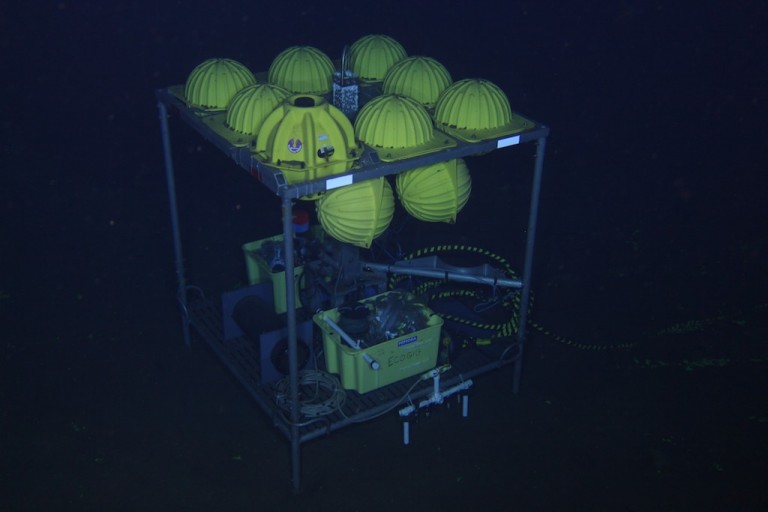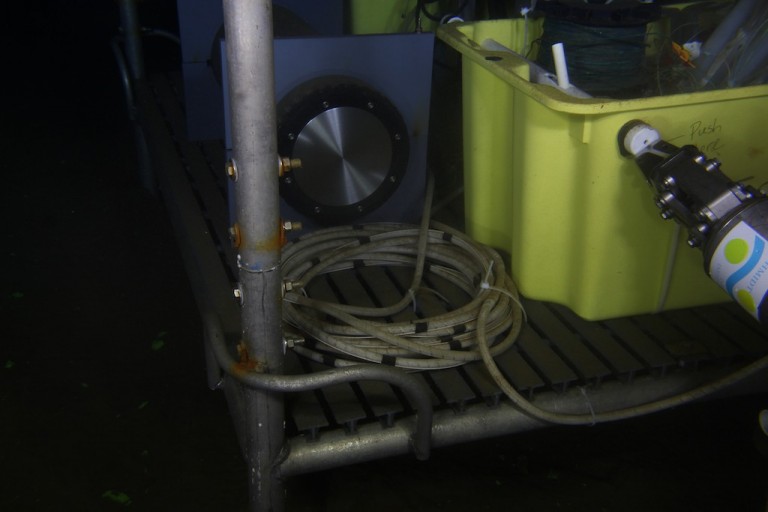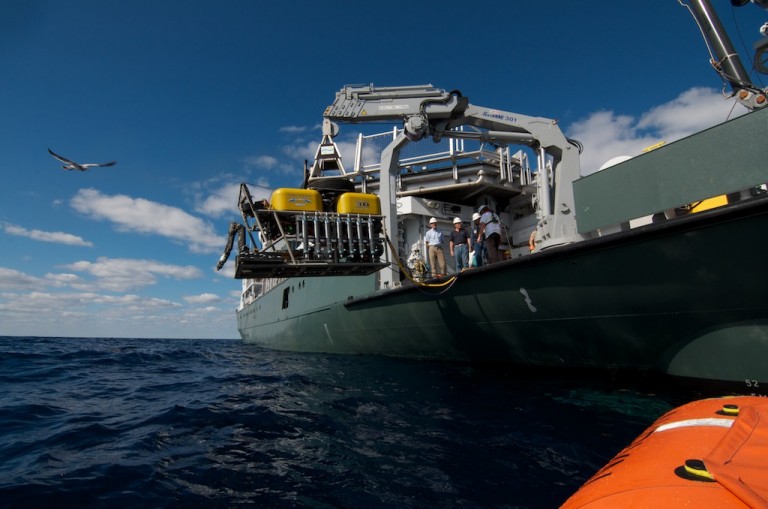The second ROV dive of the expedition took place today. Its primary objective was servicing a benthic lander that has been collecting measurements on the seafloor near the Macondo wellhead since April 2012. Dr. Beth Orcutt, a microbiologist, has a collection of sampling equipment onboard the lander and she was in charge of the ROV dive plans for lander operations.
A benthic lander is an autonomous observational platform used to conduct equipment on the seafloor. It is anchored to the seafloor with heavy weights that are typically connected to acoustic release mechanisms. To retrieve the lander, the science team returns to the site and uses an underwater transponder to produce an acoustic signal that triggers mechanism to drop the weights. Floats on the frame, usually round glass spheres protected with yellow plastic “hard hats,” provide the buoyancy for the lander to rise to the sea surface where it is then picked up by the ship.

The ECOGIG lander, built by the University of Mississippi, houses customized samplers designed to be at sea for six months. This lander has two sampling systems onboard: MIMOSA and CSA. MIMOSA (MIcrobial Methane Observatory for Seafloor Analysis) uses battery-free osmotic pumps to collect continuous water samples for methane, ions, microbial and enrichment experiments. This sampler collects samples for several ECOGIG scientists: Laura Lapham (UMCES), Beth Orcutt (Bigelow Laboratory for Ocean Sciences), Peter Girguis (Harvard University), and Geoff Wheat (University of Alaska, Fairbanks). The Chimney Sampler Array (CSA), designed by ECOGIG investigator Chris Martens (University of North Carolina), consists of vertical cylinders (chimneys) equipped with internal chemical sensors that can measure chemical and physical parameters in the benthic boundary layer plus methane and oxygen sediment-water chemical fluxes.

The ECOGIG landers are deployed in conjunction with an ROV. The lander carries the instruments to the seafloor and the ROV arrives afterwards to precisely position the sampling devices around the lander frame.
During our dive today, the ROV prepared the lander for recovery. The primary task was for the ROV to use its manipulator arm to close a high-pressure valve in the MIMOSA sampler. This valve seals off the sample to prevent it from degassing when the lander ascends through the water column. After locating the lander on the seafloor, Dr. Orcutt had the ROV close the MIMOSA valve. Then the ROV flew around the lander to document the instruments and surrounding area. Finally, the ROV flew back to the lander and positioned a measuring stick at various places around the input tubes for photos that the researchers will use in their analyses.

Now this benthic lander is ready to be recovered from the seafloor. In the next few days, R/V Falkor will head southwest to a natural seep site where a second lander is installed. When we are there, a second ECOGIG team led by Dr. Laura Lapham will arrive aboard the R/V Pelican to rendezvous with R/V Falkor for coordinated lander and ROV operations. The R/V Pelican will recover the old lander and deploy a new one. Both ships will return to the oil spill site and repeat this process. The data collected by the lander instruments are important for monitoring how the seafloor conditions change over time.
– Written by Debbie Nail Meyer for Schmidt Ocean Institute
FK006b-2012
